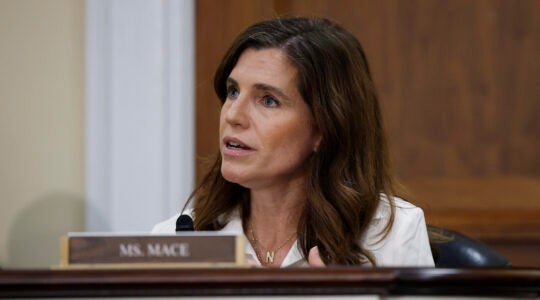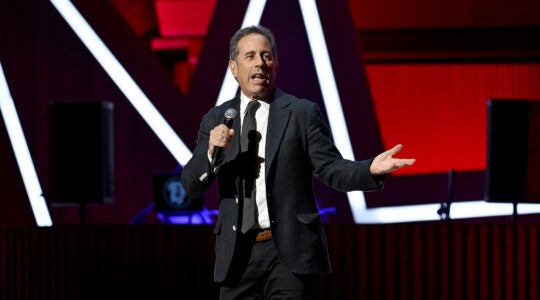SAN FRANCISCO (JTA) – When Julie Lustbader was applying to colleges last fall, she wasn’t thinking about Jewish life on campus.
Her parents were, though. They pored over a Web site set up by Hillel: The Foundation for Jewish Campus Life, particularly its online guide to Jewish life on campus that provides Jewish data on more than 500 North American colleges and universities.
“They had a 10 percent rule – any school I applied to had to be at least 10 percent Jewish,” says Lustbader, 18, who will graduate this month from Atholton High School in Columbia, Md. “And if it didn’t have a Hillel, I couldn’t even apply.”
Lustbader decided on the University of Pennsylvania, and after visiting the Hillel there, she’s glad to be attending a school with such an active Jewish student life.
“I heard the food is good, and they had a sign-up board for all these cool Jewish events – it looked really interesting,” she says.
Lustbader regrets she wasn’t involved in Jewish youth groups in high school.
“In college I want to get more involved,” she says. “I identify Jewish, and it’s nice to know I won’t be the only one keeping kosher at Passover.”
Lustbader is one of an estimated 75,000 Jewish graduating seniors who in recent weeks have made their final decisions about where to attend college. This fall, they will be part of the largest incoming freshman class in U.S. history.
Many of them may not be thinking much about their Jewish needs on campus until their first Jewish holiday rolls around, or a friend drags them to a Shabbat dinner at Chabad or a Purim party at Hillel.
That’s too late, says Jeff Rubin, Hillel’s associate vice president for communications.
“Jewish students often make decisions about what they’ll be involved in during the first week or two on campus,” he says.
Jewish student organizations have spent much time and money in the past decade beefing up their programs on campus, Rubin says. Now they’re reaching out to make connections with incoming Jewish students even before they hit campus.
“By reaching out to them ahead of time, we increase the likelihood of their being involved,” Rubin says.
Do high school students care? It depends, says Diane Bernbaum, the director of Midrasha, a Jewish community high school in Berkeley, Calif.
“The ones that have a good experience in high school want to re-create it,” she says.
That was true for Ben Bovarnic, 17, a graduating Midrasha student who will be attending a small college in the Northeast. On his visit to the school, he told his mother it reminded him of Midrasha and he wanted to go there.
“I had a number of things I was looking for, a strong Jewish community and a strong Hillel,” says Bovarnic, who asked that the school not be named for personal reasons. “I know I’m going to continue practicing Conservative Judaism, and I wanted a campus that would offer me that opportunity.”
Not all Jewish high school students are as motivated to stay connected, educators say. And not all of them go to colleges that have a strong Jewish student life.
“There are 12 to 15 universities where the most active Jewish students go, and after that it’s hit or miss,” says Richard Moline, the director of Koach, the Conservative movement’s campus organization.
Two years ago, Hillel launched a major effort to bridge the gap between high school and college in partnership with the B’nai B’rith Youth Organization, the Jewish Educational Service of North America, and the Reform, Conservative and Orthodox Jewish youth movements.
In 2006 Hillel began publishing an Internet e-zine called Chai Wire filled with information about Jewish life on campus that it sends quarterly to 50,000 high school juniors and seniors. Last year it held focus groups and sent out a survey to 20,000 Chai Wire readers to find out what those teens wanted.
Six hundred readers responded, Rubin says. Three-quarters said Jewish life on campus was an important factor in their college choice. Nearly 40 percent said they had consulted Hillel’s online guide to Jewish student life during the application process.
Last summer, Hillel began to collect names of Jewish high school seniors and pass them to Hillel directors at the schools they would be attending, so those directors could communicate with them over the summer.
By the fall of 2007, Hillel had 5,000 names. This year it hopes to collect even more.
Rubin says the process is arduous. Some names are provided by high school youth groups or, less often, by synagogues. Some can be accessed through lists of incoming freshmen at private universities, although public universities don’t collect such data.
Hillel also solicits names through Chai Wire, asking students to e-mail their contact information and where they are attending college.
Theoretically it’s a streamlined process: Hillel provides the names to on-campus directors, who send out welcome letters to incoming Jewish students. In practice, however, other factors are involved.
Keith Dvorchik is the executive director of Hillel at the University of Florida in Gainesville, with 6,500 Jewish undergraduates. Dvorchik says he receives 100 to 150 names each summer from Hillel, the B’nai B’rith Youth Organization and a handful of synagogues. He sends a welcome e-mail to each student, and says the system works pretty well for him.
Arlene Miller, the executive director of Hillel at the University of California at Los Angeles, says local Jewish communities should be more involved. Miller did receive names from Hillel last year, but most of her incoming Jewish students come from the Los Angeles area, and she says she receives little cooperation from local synagogues, youth groups and Jewish high schools.
“There’s no orchestrated system, so we have to be proactive,” Miller says. “There’s a lot more that could be done by the community to bridge the gap.”
Outreach efforts have intensified in the past two years with the introduction of Chai Wire and JESNA asking the heads of its 55 community Hebrew high schools to send the names of graduating seniors to the Hillel directors of the schools to which they were headed.
Devorah Silverman, who heads that project at JESNA, says the Hebrew high schools sent about 350 names last year.
Last year, the Orthodox Union also launched an internal effort to funnel Orthodox high school students to appropriate Jewish groups on campus.
“For 15 years I’ve been telling the O.U. they need to do this,” says David Felsenthal, who heads the O.U.’s new alumni department of the National Conference of Synagogue Youth.
Some 6,000 high school seniors are involved either in NCSY or in Jewish Student Unions, the O.U.-sponsored Jewish clubs in public schools. Felsenthal says he had 300 names by May 1; his goal is 1,000 by the end of the month.
Next year Felsenthal will move from collecting and funneling names to actually steering students to campuses with strong Orthodox life. He hopes to hire a field representative who will meet with Orthodox high school seniors and direct them to one of the 15 or 16 schools that host emissary couples affiliated with the O.U.’s Jewish Learning Initiative on Campus project.
Chabad does its own outreach to incoming freshmen, says Rabbi Hershey Novack, the co-director of Chabad at Washington University in St. Louis. Community Chabad emissaries tell campus emissaries about incoming freshmen via an internal Chabad online system, and the 125 Chabad college representatives do personal outreach to the new students when they reach campus.
Novack says the tight-knit nature of the Chabad family helps. He usually knows the Chabad rabbi that refers his incoming students, “so we already have a personal connection.”
Collecting and passing on names is only part of the overall effort to involve Jewish students in Jewish life on campus, however.
“Honestly, even if a Hillel director follows up, that doesn’t mean the kids will be meaningfully engaged,” Silverman of JESNA admits. “But it’s a start.”
JTA has documented Jewish history in real-time for over a century. Keep our journalism strong by joining us in supporting independent, award-winning reporting.





